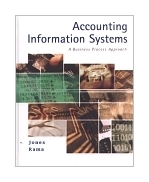|
||
podział tematyczny • wydawnictwa anglojęzyczne podział tematyczny Newsletter: • Zamów informacje o nowościach z wybranego tematu Informacje: • sposoby płatności i dostawy • kontakt • Cookies na stronie • Regulamin zakupów Napisz propresssp@gmail.com |
ACCOUNTING INFORMATION SYSTEMSJONES ., RAMA D.wydawnictwo: SW , rok wydania 2003, wydanie Icena netto: Using a business process approach, this text integrates AIS topics to provide a strong conceptual foundation in accounting systems and controls. Throughout the text, the authors emphasize the relevance of the content to accountants and the roles that they play as designer, user and evaluator of information systems. The text provides numerous problem-solving aids to help students develop competencies in documenting and analyzing transaction cycles and AIS data, identifying risks and controls, using accounting applications, and designing and evaluating AIS. A set of core cases is used throughout each chapter to facilitate integration. There is a comprehensive case at the end of the text that is designed to give students further opportunity for integration of concepts and tools. For instructors emphasizing database design and accounting applications, a database design project is also integrated in the text. A supplement is available to help students learn how a relational database (MS Access) can be used to implement an AIS. Frederick L. Jones is a Professor of Accounting at the University of Massachusetts at Dartmouth. He received an M.B.A. at the University of Maryland, and a D.B.A. at Boston University. His research interests include information systems, auditing and financial accounting, and he has related publications in the Journal of Accounting and Public Policy and the Journal of Accounting Literature. Dr. Jones is a CPA and has professional experience in internal auditing and public accounting. He is a member of the American Accounting Association, American Institute of CPAs, Beta Alpha Psi, and Beta Gamma Sigma. Dasaratha V. Rama obtained her B.Tech. degree in Electrical Engineering from the Indian Institute of Technology, Delhi and her Ph.D. degree in Business Administration from the University of Iowa. She has previously taught at Bentley College and University of Massachusetts, Dartmouth, and is currently a Professor of Accounting and Information Systems at Texas A&M International University. Rama has published extensively in the areas of Information Systems, Auditing, and Accounting Education. She served as the Editor of a monograph titled Learning by Doing: Service Learning in Accounting, published by the American Association for Higher Education. Rama also is a Certified Management Accountant. Table of Contents: I. ACCOUNTING INFORMATION SYSTEMS: CONCEPTS AND TOOLS. 1. Introduction to
Accounting Systems. II. UNDERSTANDING AND DEVELOPING ACCOUNTING SYSTEMS. 5. Understanding and
Designing Accounting Data. III. TRANSACTION CYCLES AND ACCOUNTING APPLICATIONS. 8. Using Accounting
Applications. IV. MANAGING INFORMATION TECHNOLOGY AND SYSTEMS DEVELOPMENT. 12. Using Technology to
Enhance Business Processes. 744 pages Księgarnia nie działa. Nie odpowiadamy na pytania i nie realizujemy zamówien. Do odwolania !. |


